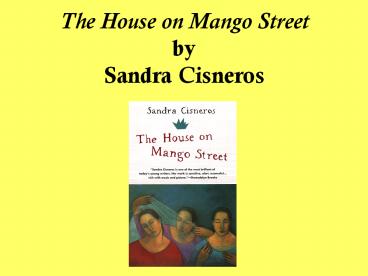The House on Mango Street by Sandra Cisneros PowerPoint PPT Presentation
Title: The House on Mango Street by Sandra Cisneros
1
The House on Mango StreetbySandra Cisneros
2
The House on Mango Street
- is set in modern-day Chicago
- is about the Hispanic culture in America
- is a book of short stories/poemsand sometimes
not even full stories, but character sketches and
vignettes - is narrated by a young MexicanAmerican girl
named Esperanza
3
Mango Street is set in the Pilsen area of Chicago
4
PILSEN
5
Chicagos Pilsen Neighborhood
- Located in the Lower West Side
- In 19th Century it was inhabited by Czech
immigrants who named the district after Plzen the
fourth largest city in what is now the Czech
Republic. - Beginning in the mid 1960s Pilsen became
increasingly Mexican. In the 1970s Pilsen became
predominantly Mexican.
6
The subjects of many of these vignettes are
Esperanzas family, neighbors, and friends.
Minerva Who Writes Poems Kiki with Hair Like Fur Gil, the Furniture Store owner Cathy Queen of Cats
Ednas Ruthie Alicia Who Sees Mice Meme Ortiz Aunt Lupe
Geraldo No Last Name The Earl of Tennessee Sire The Family of Little Feet
Note the interesting names and titles.
7
Character Map
8
The main character is named Esperanza. Her
dreams, frustrations, and hopes are also the
subjects of some of these vignettes.
- Do you know what the English translation of
esperanza is?
HOPE
9
Esperanza has hope in a seemingly hopeless
world.
- Like her character Esperanza, Sandra
Cisneros, the author, remained hopeful about her
future, despite growing up in a neighborhood
that appeared like France after World War II
empty lots and burned-out buildings.
10
- You can never have too much sky. You can fall
asleep and wake up drunk on sky, and sky can keep
you safe when you are sad. Here there is too much
sadness and not enough sky. Butterflies too are
few and so are flowers and most things that are
beautiful. Still, we take what we can get and
make the best of it.
11
This childrens book was the inspiration for The
House on Mango Street.
12
Virginia Lee Burtons book, The Little House, is
about the survival of the house despite the
disappearance of the country surrounding it as it
is replaced by skyscrapers and factories. In the
end, the house is moved back to the countryside.
Cisneros loved this book because it described
the stable family home she desired.
13
Main Ideas
- self-definition identity
- friendship, neighborhood, home
- freedom vs. entrapment
- growth maturity / sexuality
- gender roles expectations
- fitting in
- future opportunities vs. limitations
- finding ones home
14
Cisneros Life
- Her father is Mexican and her mother is
Mexican-American. - Her family moved between Chicago and Mexico City
often. - Due to the loneliness as a result of the constant
moves, she retreated into books, which became her
adolescent companions. - She began writing in secret in grade school.
- In high school she wrote poetry and edited the
school literary magazine. - She now lives in San Antonio, Texas.
15
Cisneros house in San Antonio
- The writer came under attack from the
historical community of King William when she
chose to paint her house periwinkle purple.
16
Reading Alerts
- strategic use of Spanish throughout
Cold frijoles. Esta muerto. Los espiritos
are here.
unconventional use of grammar and syntax
Bum man says, Yes, little girl.
17
Reading Alerts (cont)
adolescent/childlike perspective of the world
Everything is holding its breath inside me.
beautiful, poetic language figurative language
You can never have too much sky.
a long list of characters (chapter notes while
reading are helpful in remembering them)
Mama, Papa, Carlos, Kiki, Nenny, and me.
18
About her book, Cisneros says, I wanted
- to write stories that read like memoirs,
- to tell one big story, each story contributing to
the wholelike beads in a necklace, - to change the way someone thinks about my
community, or my gender, or my class.

